#62 in Vietnam
Popular Ốc Variations

Ốc Bươu
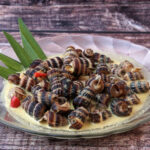
Ốc Len

Ốc Hương

Ốc Giác
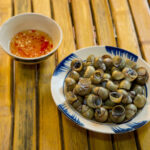
Ốc Gạo
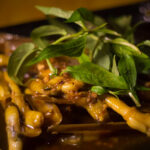
Ốc Móng Tay
Ốc: Ingredients and Preparation
Main Ingredients
Main Cooking Method
Preparation Process
Ốc: A Deep Dive
Cultural Significance
Taste
Texture
Aroma
Color
Serving Style
Serving Temperature
Accompaniment
Occasions
Seasons
Special Diets
Calories
Popularity
Popular Similar Dishes
Popular Dining Area
Ốc (also known as snail) is a favorite delicacy in Vietnam. There are several types of edible snails, which are either farmed or harvested from rivers or seas in this Southeast Asian country.
And thanks to Vietnam’s long coastline with abundant rivers and canals, it has a diverse source of snails.
Snails are especially popular as street food in Saigon (aka Ho Chi Minh City).
They can also be easily found in restaurants or eateries along the coast of Vietnam. Each region has different types of snails, and their preparation methods also vary.
However, when it comes to the diversity of snail types and cooking methods, Saigon is a paradise for exploring this food.
Despite not being a coastal city, the high consumption of snails in this city leads to an impressive variety of snails sourced from across the country, making it a hub for snail lovers.
Plus, to an impressive variety of snails sourced from across the region.
As there are so many snail variants in Vietnam, I’ll only show the most well-loved ones that I recommend you try the first time.
There are also some common cooking techniques that locals normally use to prepare ốc.
Moreover, since snail is a strange food that not everyone dares to try, I also provide some considerations in consuming this food.
Then, don’t skip the pros and cons part to have a full view of Vietnamese-style snails and other commonly asked questions about them. Finally, take a quick look at the similar dish section to explore more!
Key Points
What Are Popular Types of Ốc in Vietnam?
Vietnam is renowned for many ốc varieties. Here are the nine most popular choices among locals and tourists.

Ốc Bươu
Often found in rice fields; dark green and non-glossy shell; very popular in Northern Vietnam.

Ốc Len
A marine species; has a dark brown color with white streaks; small in size with small, spiral ridges; normally stir-fried with coconut milk
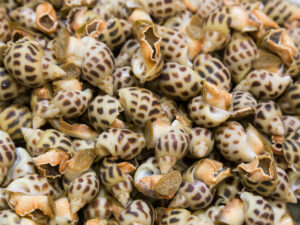
Ốc Hương
A mollusk species; has a delicious meat; high price in the market

Ốc Giác
A large snail; meaty flesh with a firm and chewy texture

Ốc Gạo
Popular in the Mekong Delta region; has a bluish-white, spirally coiled shell with a pointed tip at the rear.

Ốc Móng Tay
A moderately-sized snail, resembling a finger in shape; has a pale white and thick flesh.
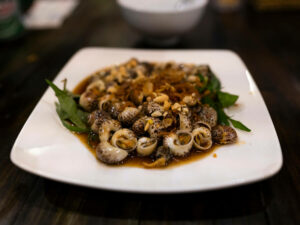
Ốc Mỡ
Slightly chewy flesh; commonly stir-fried with tamarind or garlic sauce.

Sò Lông
Prominently found in provinces such as Kien Giang and Ca Mau; the surface of the shells is covered with a thin layer of brown ‘hair’

Sò Huyết
Has red hemoglobin liquid inside and red-colored gut; highly valued for its nutritional content.
After exploring these popular types of Vietnamese snails, it leads us to learn about creative cooking methods that bring out their tastes and textures.
What Are Common Cooking Methods For Preparing Ốc?
Here are four common ways to cook ốc in Vietnam, including
- Boiling: A simple and popular method where snails are boiled in water, often with added aromatics like lemongrass, ginger, or herbs.
- Grilling: Snails are grilled over an open flame, sometimes after being marinated in spices and sauces.
- Stir-frying: Snails are stir-fried with various ingredients like chili, lemongrass, garlic, tamarind, coconut milk, or vegetables.
- Steaming: This method preserves the natural flavor of the snails, often steamed with herbs or lemongrass.
While enjoying the flavorful preparations of ốc, it’s essential to consider some key factors to enhance the dining experience and ensure safety, which is discussed below.
What Are the Important Considerations For Eating Ốc?
The following are four essential notes for the safe consumption of ốc, such as:
- Clean Snails Properly Before Cooking: Snails can contain harmful parasites. Clean them with rice water, vinegar, or salt and lemon water to remove dirt and reduce health risks.
- Avoid Over-Soaking or Immediate Use: Snails kept too long or soaked excessively can spoil or die, increasing the likelihood of foodborne diseases.
- Cook Snails Thoroughly: Ensure snails are fully cooked to kill parasites and prevent digestive issues or foodborne problems.
- Don’t Eat Snails with Vitamin C-rich Foods: Combining snails with high vitamin C foods can create harmful compounds, leading to abdominal pain, bloating, and potentially food poisoning.
In the next part, let’s explore the advantages and potential drawbacks of indulging in this seafood of Vietnam.
Pros and Cons of Eating Ốc
Below is a comprehensive table outlining the various advantages and disadvantages of savoring ốc, a beloved street food.
Pros
Cons
Having discussed the pros and cons, you should continue reading for further information about ốc.




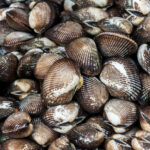


Truc Tran (Kris)
Senior Food Editor
Expertise
Home Cooking, Meal Planning, Recipe Development, Baking and Pastry, Food Editor, Cooking-video Maker, Vietnamese Food Evaluation Expert
Education
Truc Tran (Kris), an experienced food writer and editor, is great at exploring and describing global cuisines, from simple street food to fancy dining. In her writing, she skillfully mixes different flavors, cooking methods, and culinary traditions, showing the unique character of various cultures through their food and drinks. On azcuisines.com, Kris highlights her knowledge, especially in Asian cuisine and worldwide traditional dishes.